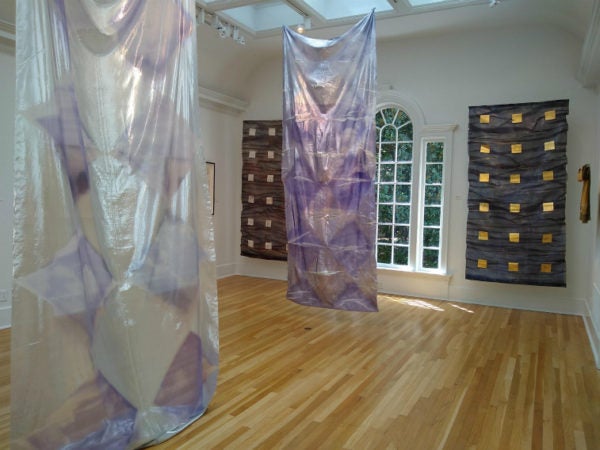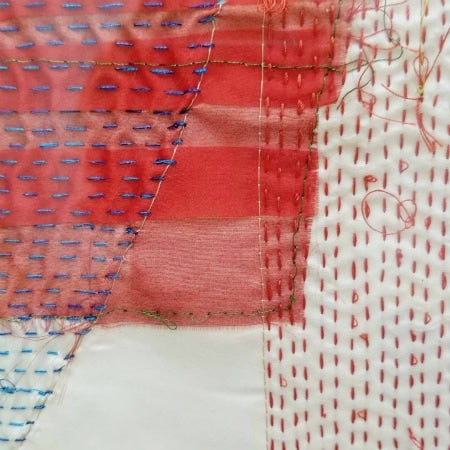
Junco Sato Pollack’s exhibition “Meditation in Space and Time” at Swan Coach House Gallery is a retrospective of the Japanese-born fabric artist’s work in the sense that the pieces included by curator Marianne Lambert were created between 1995 and now. What most unites the work on view, however, is not the artist’s personal history but her practice of metaphorically applying stitch after spiritual stitch through meditation.
Pollack’s work is inspired by the Zen practice of sutra-chanting and the image of meditation as internalized stitching. Sutras are Buddhist texts, and the word sutra itself derives from the Sanskrit root for sewing. Reciting a sutra is both a means of internalizing its specific meaning and, through repetition, of moving past that particular meaning. Thus chanting is a means as well as an end. Regarding the connection between chanting and stitching, Pollack notes in her statement, “When extended over time, stitch-by-stich and layer-by-layer, these actions transform into artworks depicting a complete universe, micro- and macro- energy fields, and the mindscape.”
Thirty years of working with textiles and two decades of meditation have allowed Pollack to completely integrate her spiritual and artistic practices. Art-making guided by a spiritual practice results in many forms. Even within Zen Buddhist art, you may find both the completely spontaneous and the deliberately process-oriented. Spiritual and artistic practices often share certain aspects, including attention to technique and prolonged periods of inwardness. Buddhist practices in particular have shared space with modern and contemporary art, a connection explored at length in Buddha Mind in Contemporary Art, a 2004 collection of essays edited by Jacquelyn Baas and Mary Jane Jacob that aims to “elucidate the common ground between the creative mind, the perceiving mind, and the meditative mind.”

In addition to sutra-chanting as a metaphor—indeed, a parallel—for Pollack’s textile art, similar visual reminders also appear in Buddhist texts. A work showing grids made of textiles with dye-sublimated forms placed neatly within them are visually reminiscent of sutra pages: hand-calligraphed Chinese characters within columns of fine, gold-inked lines, a convergence of devotional and artistic efforts.
Several large textile works are hung freely, evoking the distinction between the fixed and moving mind, and the illusion of this dichotomy. Certain aesthetic qualities of textile art resonate with Buddhist philosophy: textile art is less bound to two dimensions and immobility than a painting or drawing. Textiles such as clothing or pillowcases conform to the shape to the thing they envelope: their form is therefore, in a sense, formless. Textiles like flags can also conform to air, although according to the Zen koan, it’s neither the flag nor the wind that moves, but the mind. This teaches that objects which change or seem to possess no fixed, inherent nature force the viewer to reconsider their objecthood.
The exhibition prominently features a workspace area where viewers are invited to select pieces of fabric and spools of thread to participate in making a collectively constructed textile mandala. The desk, scissors, and other materials at the workspace serve as a reminder that sewing is a basic household activity: darning a sock and stitching on a button are utilitarian, everyday actions. Zen traditions suggest many equivalences between such daily tasks and spiritual work: sweeping, washing dishes, and other domestic chores are correlated by teachers with Buddhist practice.
Hand-stitching and dye-sublimation techniques appear in many works throughout the exhibition. Both are employed in a loose manner, showing individuality and expressiveness rather than exactitude and technological flash. Dye sublimation allows textile artists to create subtle, layered effects not usually associated with more traditional textile work. Conceptually, however, the processes Pollack employs are never far from her meditative practice. She has described a change in her awareness amid the stitching process: “At certain point my vision shifted, and I had no doubt that I was raking sand in the sand garden of Ryoanji, and sweeping moss.”
“Meditation in Space and Time” remains on view at Swan Coach House Gallery through September 21.




